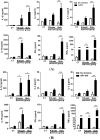Immune memory to Sudan virus: comparison between two separate disease outbreaks
- PMID: 25569078
- PMCID: PMC4306827
- DOI: 10.3390/v7010037
Immune memory to Sudan virus: comparison between two separate disease outbreaks
Abstract
Recovery from ebolavirus infection in humans is associated with the development of both cell-mediated and humoral immune responses. According to recent studies, individuals that did not survive infection with ebolaviruses appear to have lacked a robust adaptive immune response and the expression of several early innate response markers. However, a comprehensive protective immune profile has yet to be described. Here, we examine cellular memory immune responses among survivors of two separate Ebolavirus outbreaks (EVDs) due to Sudan virus (SUDV) infection in Uganda-Gulu 2000-2001 and Kibaale 2012. Freshly collected blood samples were stimulated with inactivated SUDV, as well as with recombinant SUDV or Ebola virus (EBOV) GP (GP1-649). In addition, ELISA and plaque reduction neutralization assays were performed to determine anti-SUDV IgG titers and neutralization capacity. Cytokine expression was measured in whole blood cultures in response to SUDV and SUDV GP stimulation in both survivor pools, demonstrating recall responses that indicate immune memory. Cytokine responses between groups were similar but had distinct differences. Neutralizing, SUDV-specific IgG activity against irradiated SUDV and SUDV recombinant proteins were detected in both survivor cohorts. Furthermore, humoral and cell-mediated crossreactivity to EBOV and EBOV recombinant GP1-649 was observed in both cohorts. In conclusion, immune responses in both groups of survivors demonstrate persistent recognition of relevant antigens, albeit larger cohorts are required in order to reach greater statistical significance. The differing cytokine responses between Gulu and Kibaale outbreak survivors suggests that each outbreak may not yield identical memory responses and promotes the merits of studying the immune responses among outbreaks of the same virus. Finally, our demonstration of cross-reactive immune recognition suggests that there is potential for developing cross-protective vaccines for ebolaviruses.
Figures




References
-
- Kuhn J.H. Filoviruses. A compendium of 40 years of epidemiological, clinical, and laboratory studies. Arch. Virol. Suppl. 2008;20:13–360. - PubMed
-
- Albarino C.G., Shoemaker T., Khristova M.L., Wamala J.F., Muyembe J.J., Balinandi S., Tumusiime A., Campbell S., Cannon D., Gibbons A., et al. Genomic analysis of filoviruses associated with four viral hemorrhagic fever outbreaks in uganda and the democratic republic of the congo in 2012. Virology. 2013;442:97–100. doi: 10.1016/j.virol.2013.04.014. - DOI - PMC - PubMed
Publication types
MeSH terms
Substances
Grants and funding
LinkOut - more resources
Full Text Sources
Other Literature Sources
Medical
Molecular Biology Databases

